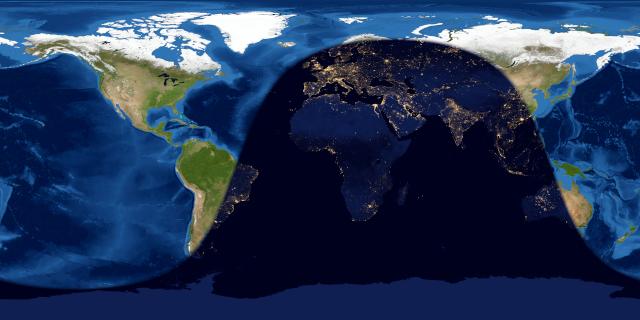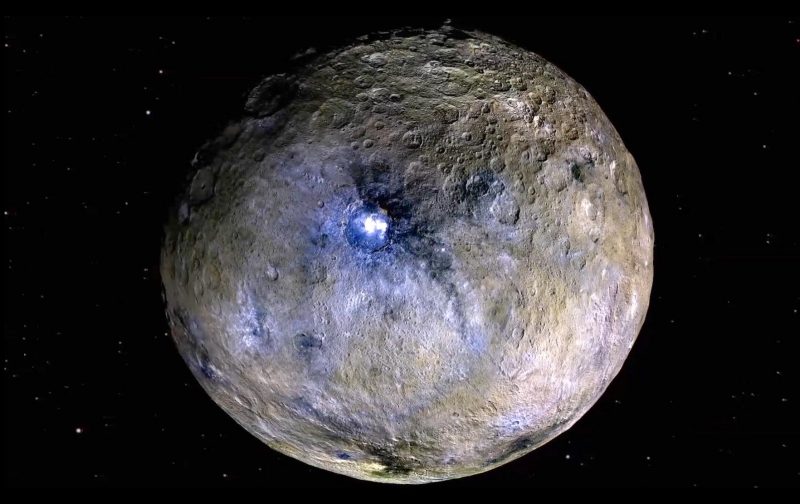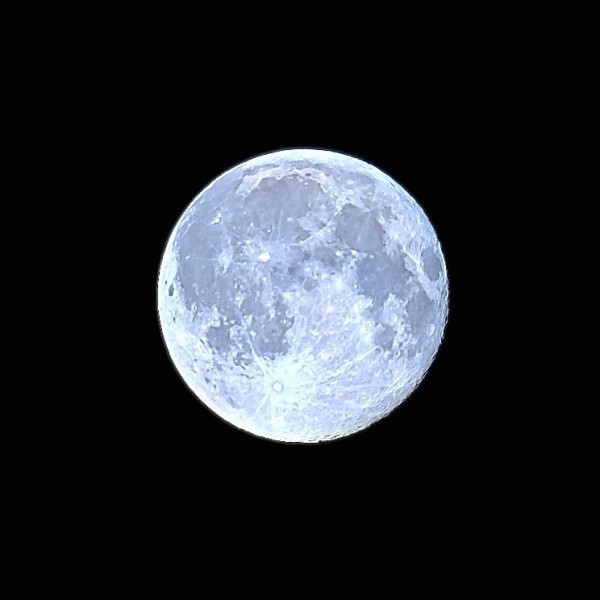
These next several nights – May 17, 18 and 19, 2019 – the moon will be full, or nearly full, and many will call Saturday night’s moon a Blue Moon. Wait. Is it the second full moon of this month? No, but folklore allows for another kind of Blue Moon: the third of four full moons to occur in a single season, in this case the season between the March equinox and June solstice. We’ll elaborate on this type of Blue Moon later on this page, or you can go ahead and get the full story on Blue Moons here. This particular Blue Moon will be near a bright star, and an even-brighter planet, and it’s poised to occult an unseen object in your sky, the first of its kind to be discovered in the year 1801 – variously called an asteroid or minor planet, now officially a dwarf planet – Ceres.
But about that Blue Moon. Will it look blue in color? Of course not, unless your local sky conditions call for it. It’ll look like any ordinary full moon. To astronomers, the moon is truly full at a precisely defined instant, when the moon is exactly 180 degrees opposite the sun in ecliptic longitude. That full moon instant falls on May 18 at 21:11 UTC. It happens at the same moment for all of us worldwide, yet the time on our clocks vary by time zone. At Canadian and U.S. time zones, the moon turns full on May 18 at 6:11 p.m. Atlantic Time, 5:11 p.m. Eastern Time, 4:11 p.m. Central Time, 3:11 p.m. Mountain Time, 2:11 p.m. Pacific Time, 1:11 p.m. Alaskan Time and 11:11 a.m. Hawaiian Time. Translate UTC to your time.
In other words, for North America, the moon turns full during the daylight hours on May 18, when the moon is still below the horizon.
Never fear. You won’t miss it. For all of us around the world, the moon stays more or less opposite the sun for several nights around full moon. We’ll all see the moon shining in the east at dusk, climbing highest up for the night around midnight and in the west at dawn.
Two noteworthy luminaries should be easy to see near this bright moon, despite its glare. The bright star Antares in the constellation Scorpius, and the planet Jupiter, follow the moon into the sky by early to mid-evening.
For the fun of it, we also show another celestial object on our chart at top – a famous one in astronomical history, and recently visited by a spacecraft – but seldom seen by earthly gazers. That is the dwarf planet Ceres which isn’t visible to the unaided eye. It helps to have a moonless night, a good sky chart and binoculars to see this little world, which orbits our sun in the asteroid belt between Mars and Jupiter. In fact, it’s the largest body in the asteroid belt (little wonder it was found first of all the asteroids, over 200 years ago, accidentally, by Italian priest and astronomer Giuseppe Piazzi).
Ceres is a good two times fainter than the faintest star visible to the eye alone on a dark night. Less than one day after the moon turns full, the moon will occult – or temporarily cover over – this little world. You’d have to be in Antarctica to witness the occultation. Elsewhere around the world, the moon will swing to the south of Ceres.
However unlikely you are – or anyone is – to witness this occultation, it’ll be fun think of little Ceres on these nights, in the moon’s vicinity.


What makes the May 18th full moon a Blue Moon?
Some of you may be familiar with the more popular monthly definition of the Blue Moon as the second of two full moons in a single calendar month. Believe it or not, the seasonal definition of Blue Moon as the third of four full moons in one season is older than the monthly definition of the term. A season is the period of time between an equinox and a solstice – or vice versa.
Some people might prefer the seasonal definition of Blue Moon because it’s based on natural phenomena (equinoxes and solstices) instead of an artificial constraint (calendar month). Normally, a season only has three full moons, but the present season actually has four.
Notice the dates below. You can see that the first full moon of the season came soon enough after the March 2019 equinox to allow for a fourth full moon to take place before the June 2019 solstice:
Equinox: March 20, 2019
Full moon: Mar 21, 2019
Full moon: Apr 19, 2019
Full Moon: May 18, 2019 (Blue Moon)
Full moon: Jun 17, 2019
Solstice: June 21, 2019
Possible to have only two full moons in a single season?
In a period of 19 years, there are 235 full moons but only 76 seasons. If each season has exactly three full moons, then 76 seasons would harbor 228 full moons (76 x 3 = 228 full moons). Yet there are an extra 7 full moons (235 – 228 = 7 extra full moons) in this 19-year period, each of which has to fall within the framework of another season. In other words, it’s inevitable that 7 out of the next 76 seasons should harbor four full moons.
The 7 seasonal Blue Moons in the next 19-year lunar cycle:
1) August 22, 2021
2) August 19, 2024
3) May 20, 2027
4) August 24, 2029
5) August 21, 2032
6) May 22, 2035
7) May 18, 2038
Read more … Blue Moon: All you need to know

Bottom line: In North America, we often call the May full moon the Flower Moon, Milk Moon or Planting Moon. But, in 2019, it’ll also be a seasonal Blue Moon, the third of four full moons to occur after the March 2019 equinox and before the June 2019 solstice. This Blue Moon will be near the bright star Antares and brighter planet Jupiter. It’ll be poised to occult, or cover, dwarf planet Ceres.











